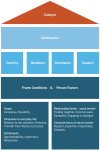Exploring the Mechanisms Underlying the Effectiveness of Psychosocial Aftercare in Pediatric Chronic Pain Treatment: A Qualitative Approach
- PMID: 35327779
- PMCID: PMC8946967
- DOI: 10.3390/children9030407
Exploring the Mechanisms Underlying the Effectiveness of Psychosocial Aftercare in Pediatric Chronic Pain Treatment: A Qualitative Approach
Abstract
A newly developed specialized psychosocial aftercare program (PAC) for pediatric patients with chronic pain following an intensive interdisciplinary pain treatment (IIPT) was found to be significantly more effective than IIPT alone. This qualitative study aimed to gain further insight into the mechanisms and prerequisites for the effectiveness of this specialized aftercare program. We conducted structured telephone interviews with patients, parents, and health care professionals conducting PAC. A total of 16 interviews were conducted-seven interviews with parents, six interviews with patients, and three interviews with health care professionals-and transcribed verbatim. Data were analyzed using reflexive thematic analysis. Four major themes consisting of 20 subcategories were identified, namely (1) frame conditions, (2) person factors, (3) stabilization and (4) catalyst. The foundations of treatment success are frame conditions, such as flexibility or constancy, and person factors, such as respect or expertise. Based on these foundations, stabilization is achieved through security, mediation, orientation and support. Altogether, these components of PAC reveal their potential as catalysts for further improvement even after discharge from IIPT. Overall, patients and their families emphasized widespread personal relevance and acceptance of the PAC program. The findings of this study may be employed in the development of other aftercare programs or interventions involving families in the context of psychotherapeutic and psychosocial health care.
Keywords: IIPT; family-based intervention; pediatric chronic pain; psychosocial aftercare; qualitative interview study.
Conflict of interest statement
The authors declare no conflict of interest.
Figures
Similar articles
-
Effectiveness of a Psychosocial Aftercare Program for Youth Aged 8 to 17 Years With Severe Chronic Pain: A Randomized Clinical Trial.JAMA Netw Open. 2021 Sep 1;4(9):e2127024. doi: 10.1001/jamanetworkopen.2021.27024. JAMA Netw Open. 2021. PMID: 34570203 Free PMC article. Clinical Trial.
-
A randomized controlled trial on long-term effectiveness of a psychosocial aftercare program following paediatric chronic pain treatment: Who benefits the most?Eur J Pain. 2022 Sep;26(8):1746-1758. doi: 10.1002/ejp.1998. Epub 2022 Jul 6. Eur J Pain. 2022. PMID: 35762280 Clinical Trial.
-
The effects of psychosocial aftercare following pediatric chronic pain treatment withstand the coronavirus disease 2019 pandemic: long-term outcomes of a randomized controlled trial.Pain Rep. 2024 Dec 24;10(1):e1226. doi: 10.1097/PR9.0000000000001226. eCollection 2025 Feb. Pain Rep. 2024. PMID: 39726850 Free PMC article.
-
Parents' and carers' experiences of transition and aftercare following a child's discharge from a paediatric intensive care unit to an in-patient ward setting: A qualitative systematic review.Intensive Crit Care Nurs. 2019 Apr;51:35-44. doi: 10.1016/j.iccn.2018.10.003. Epub 2018 Nov 16. Intensive Crit Care Nurs. 2019. PMID: 30448084
-
Cue-based versus scheduled feeding for preterm infants transitioning from tube to oral feeding: the Cubs mixed-methods feasibility study.Health Technol Assess. 2021 Dec;25(74):1-146. doi: 10.3310/hta25740. Health Technol Assess. 2021. PMID: 34878383
Cited by
-
A meta-ethnography of how children and young people with chronic non-cancer pain and their families experience and understand their condition, pain services, and treatments.Cochrane Database Syst Rev. 2023 Oct 5;10(10):CD014873. doi: 10.1002/14651858.CD014873.pub2. Cochrane Database Syst Rev. 2023. PMID: 37795766 Free PMC article. Review.
-
Effectiveness of Non-Pharmacological Interventions in the Management of Pediatric Chronic Pain: A Systematic Review.Children (Basel). 2024 Nov 25;11(12):1420. doi: 10.3390/children11121420. Children (Basel). 2024. PMID: 39767849 Free PMC article. Review.
References
-
- Ospina M., Harstall C. Multidisciplinary Pain Programs for Chronic Pain: Evidence from Systematic Reviews. Alberta Heritage Foundation for Medical Research; Edmonton, AB, Canada: 2003. p. 48.
LinkOut - more resources
Full Text Sources


